I remember very distinctly what my first pair of spectator shoes looked like: they were Derbies with light brown and off-white uppers. The brown part was brogued, and I wore them rather frequently with navy pants, but they always looked best with brown slacks. Today, I still wear spectators occasionally, and I receive many compliments on them. However, I also know that many men believe they can’t pull off wearing this bold shoe. In short, you absolutely can! Today, I’d like the share our guide about two-tone spectator shoes that will help you set aside any anxiety and enjoy the shoes for what they are – beautiful pieces of footwear that are particularly suited to wear in summer.
Very unusual spectator Exotic Leather Spectator Spectator boot
What is A Spectator Shoe?
Simply put, the spectator is a shoe with two different colors. It doesn’t matter if it is an Oxford, a Derby or a Loafer, all that matter that is has two distinct tones on the upper.
Purists would like to limit the contrasting colors to black/white or brown/white and insist upon all leather materials. However, you can find all kinds of other variations, for example in navy/gray velour leather, black/beige leather and fabric or light brown/dark brown leather. Basically, the options are endless, and that gives you the benefit of choosing a color combination that suits you.
Despite that, the majority of spectators are wingtip oxfords in either white/black or white/brown. The use of white makes them more summery.
Sometimes, you will find shoes that are even more narrowly defined, such as the saddle shoe with its contrasting middle part – the saddle. Although it is technically a spectator, it is always referred to as saddle shoe because it describes the style more narrowly.
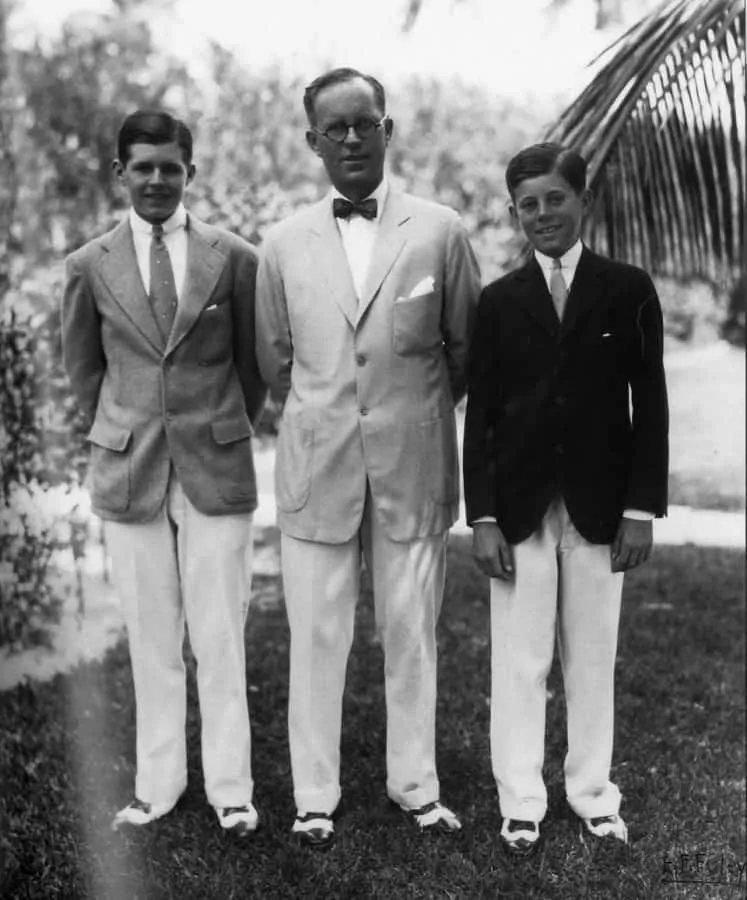
Spectator History
The history of the spectator is a bit muddled. Most sources give the honor to John Lobb, the famous English bootmaker, who, in fact, claims to have made the first spectator as a cricket shoe in 1868. At the time, cricket shoes used to be all white but during the game they would soil very quickly. John Lobb added black leather to the areas that usually get dirty immediately, and the spectator was born. In England, it is also known as the co-respondent shoe. Some claim the shoe got its name from the people who wore them because back then a co-respondent was a silver-tongued individual with a questionable past, who charmed his way into the bed of an innocent young women. Others associate the name with the corresponding colors of the shoes.
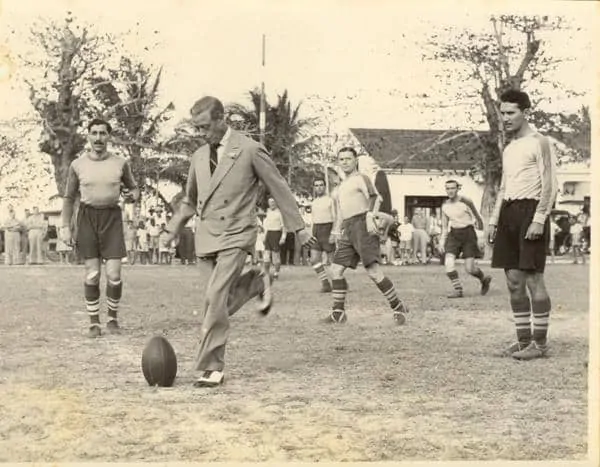
Some also claim that Spats were the predecessor to spectators, but that theory doesn’t quite fit. Spats only covered the top of a boot or shoe, which doesn’t match up with the color placement on the spectator.
In any case, the origins seem questionable; vintage fashion illustrations show two-tone shoes predating 1868.
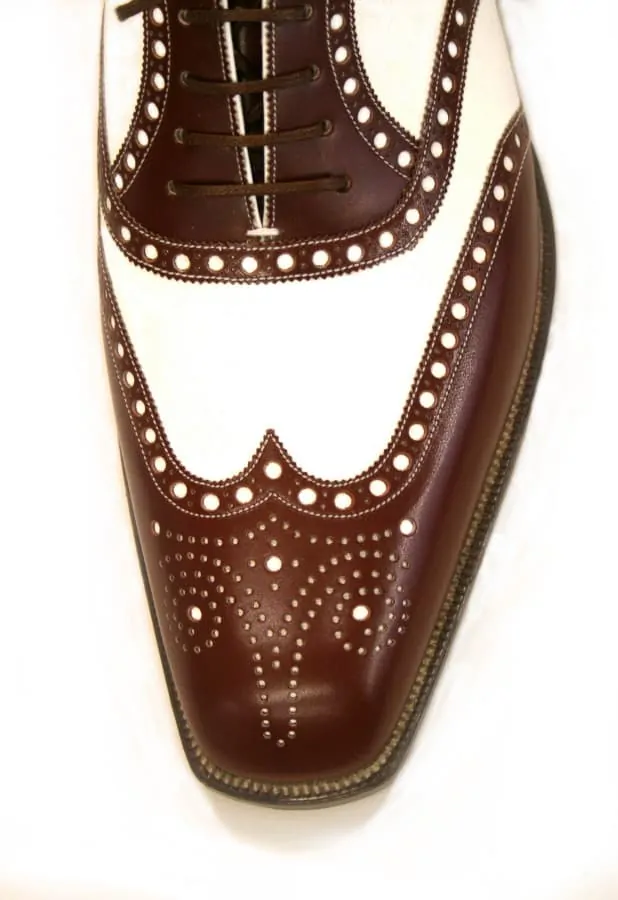
Colonial Style Shoes
Interestingly, the Colonial British set favored a two-tone shoe with brown leather and contrasting beige canvas in tropical locations, and you can still find this combination of materials around today. So, don’t shy away from canvas/leather shoes as they have a long-standing history with British gentlemen.
Colonial Style Spectator with Canvas by Crockett & Jones Colonial Style Spectator with Canvas by Crockett & Jones top view Colonial Style Spectator with Canvas by Crockett & Jones side view
Perforated Spectators
Since spectators used to be a summer favorite, vintage versions often came with perforated leather uppers for increased breathability. Perforation is not to be confused with brogueing, which is merely decorative. Today, you will only find these shoes when ordering a bespoke pair or a higher end Made-To-Order shoe. If you can get your hands on a pair of those, consider yourself lucky because not only will they be unique and stylish, they will also be functional. An alternative to perforated leather is woven leather, which is something you will see on occasion.
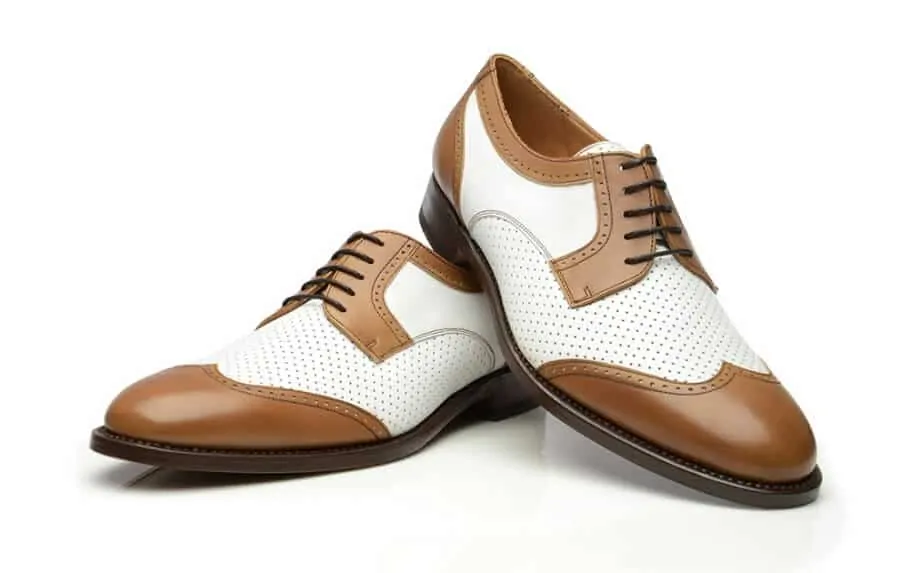
Evolution of The Spectator
In England, the spectator was considered a bit too flamboyant for gentleman up until the 1930s. At the same time, it was a popular choice among a certain set of men who were called lounge lizards and cads, neither of which are flattering labels. However, in the Golden Thirties, the Duke of Windsor wore a lot of spectator loafers, and his endorsement pushed more and more English men would follow suit, and the co-respondent became an acceptable dress shoe.
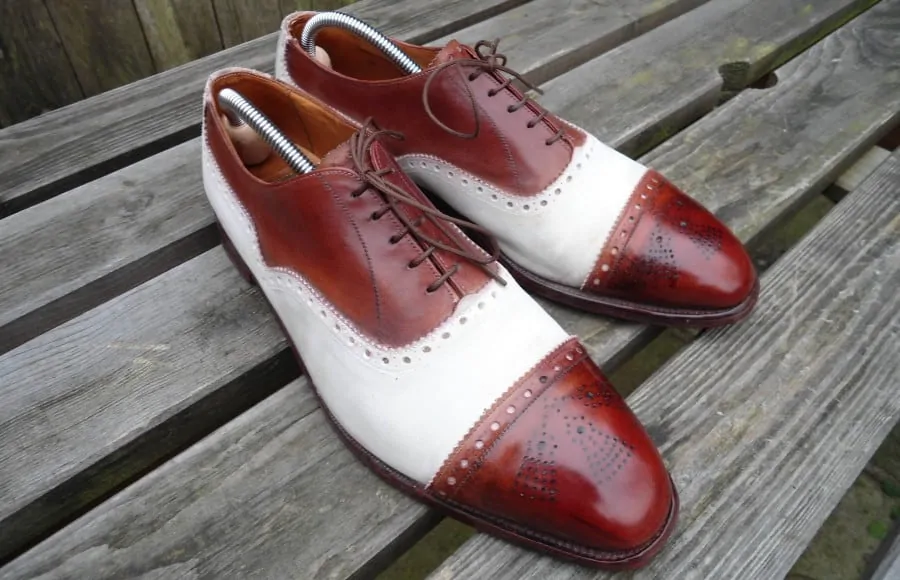
In the US, they were favored by musicians and gangsters in the 1920s and 30s, and soon became synonymous with the jazz scene and the Roaring Twenties. According to some, the blend of black and white also had an ideological background. Once Jazz musicians had popularized this shoe style, many actors would follow. Some of the most memorable wearers of spectator include Louis Armstrong, Al Capone, Fred Astaire, President Truman and the Duke of Windsor.
WWII put and end to the popularity of the spectator, and it would never gain the same popularity again. During the 1980s, it saw a revival among the new wave of young musicians with Michael Jackson leading the way, but it didn’t influence the elegant set.
Today, it is popular with swing dancers and men who admire the glorious twenties and thirties.
Semi Brogue with white suede by the Uptown Dandy Penny Loafer Spectators Navy Sude and brown boxcalf Spectator
How To Wear Spectators Today
If you wear spectators today, you certainly exude confidence because it requires a bit of thought when putting together an outfit. Personally, I think spectators look fantastic with white flannel slacks or brown suits. Some also wear them with navy striped suits although that will more likely earn you “gangster look” comments rather than, “Oh, how elegant” compliments.
The spectator is a somewhat casual style and hence it is inappropriate for formal occasions. At the same time, it may also be too loud for many office environments, but it is the perfect shoe for weekend outfits, casual Fridays, outdoor weddings or garden parties when paired with a sport coat and solid pants. It will always exude the flair of the Golden Age of men’s style and elevate your outfit. The key is to keep all other pieces subtle, so the shoes can shine without overpowering your outfit.
Because the shoes are more noticeable than most dress shoes, you should keep the rest of your outfit simple. For example, a navy blazer, with off-white slacks, a striped or printed tie, and a light blue shirt are the perfect companion for a pair of spectator shoes.
Spectators have traditionally been favored on golf courses and you can wear them there as well today.
Moreover, if you are a dancer, you should definitely invest in a pair of spectators, especially if you like swing. It just goes well with the music, and you want to look the part on the parquet floor.
The recent remake of The Great Gatsby has certainly helped to put a spotlight on the spectator shoe again. The movie is a good starting point along with our review of the styles seen in the film.
Crockett & Jones Ebury Spectator Double Monk in Navy Unusual Derby Spectator Chocolate brown and off white spectator Burnished Spectator
What Spectators To Buy
If you want a British version of spectator shoes, look no further than Crockett & Jones. They offer classic, yet elegant lasts as spectators in black/white or brown/white as well as unusual models such as a double monk strap spectator with canvas. With their MTO program, you can even create your very own two-tone look.
For U.S. made spectators, Allen Edmonds is certainly one of the best options for spectator shoes. I have a pair from them made on the Bel Air last and it is gorgeous. I don’t think they offer this model anymore, but they often come out with special editions and they always have spectators in their lineup.
If you are looking for an extensive selection of two-tone shoe styles checkout Shoepassion.
Apart from that, you can find many other brands that offer spectator shoes and bespoke shoes are always an option, if you are so inclined.
This article was wtitten by Sven Raphael Schneider and Vikram Nanjappa
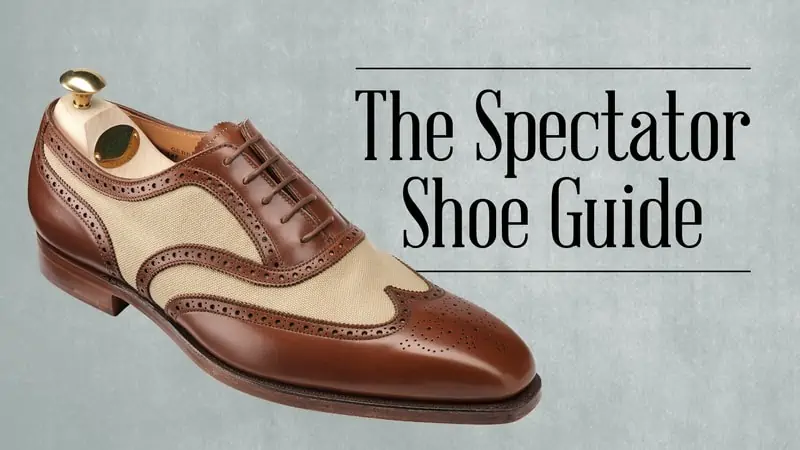
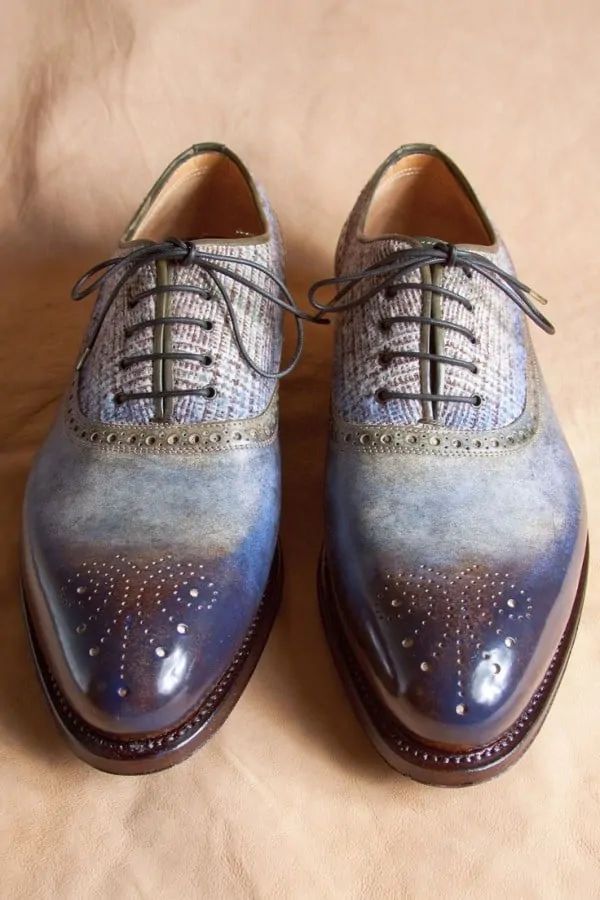
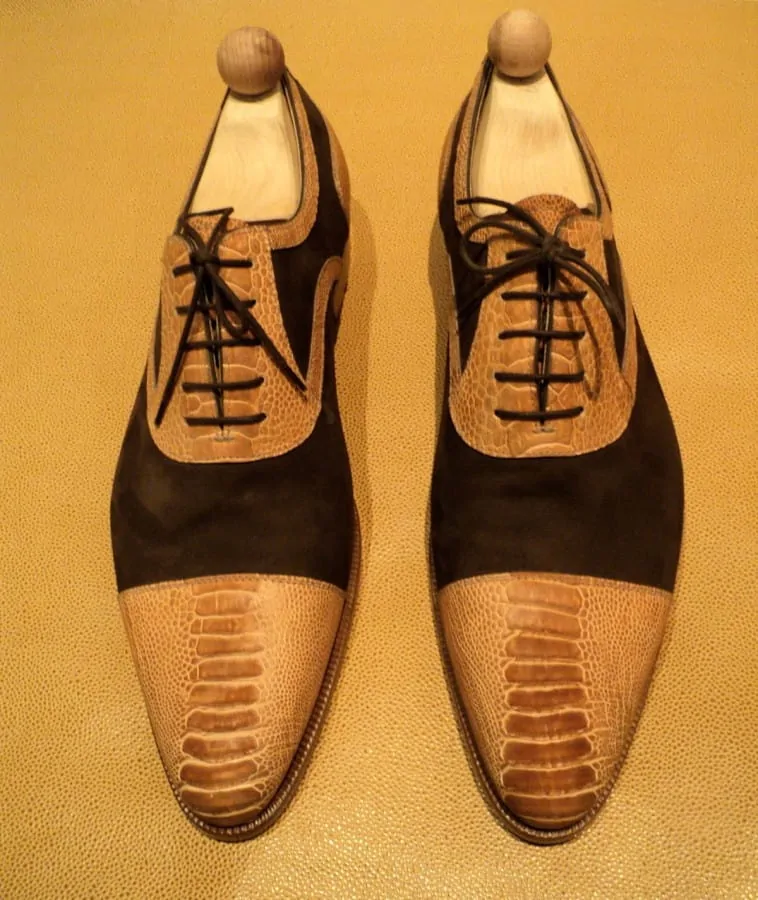
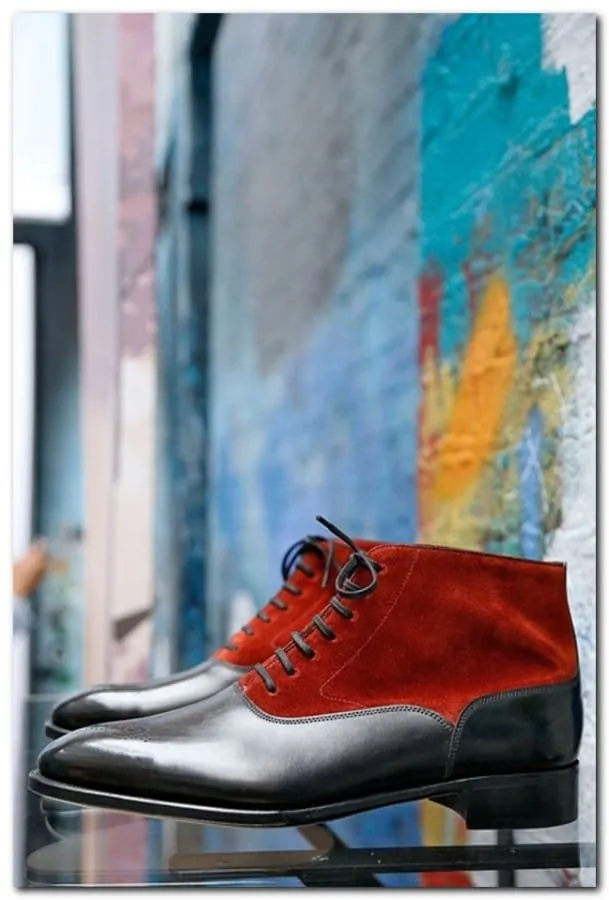
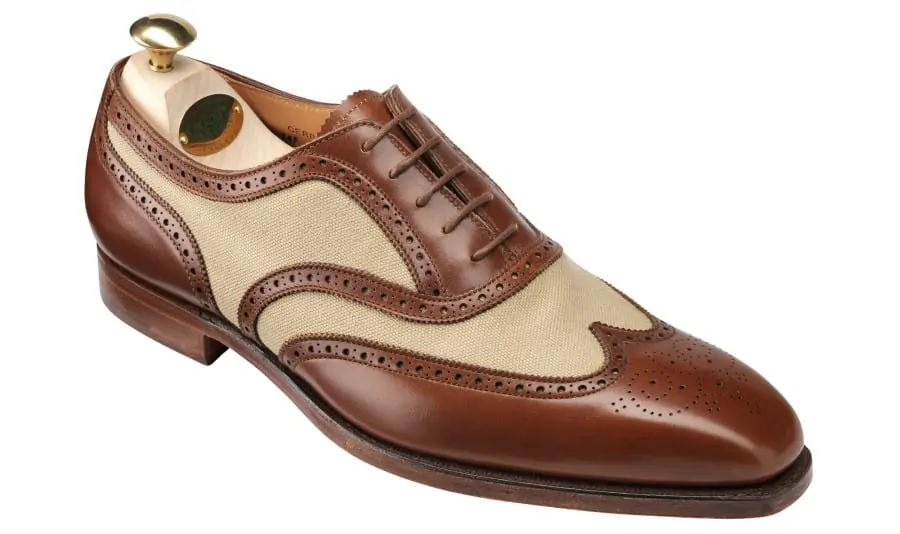
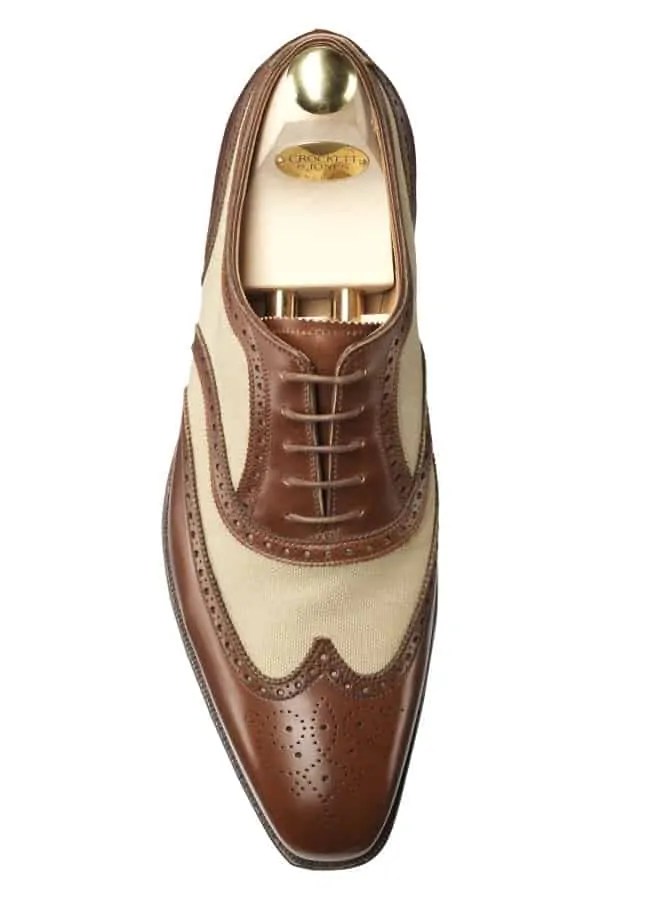
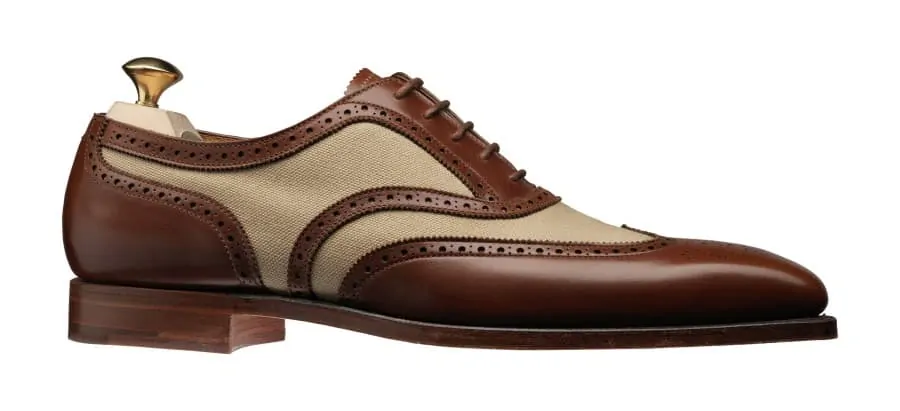
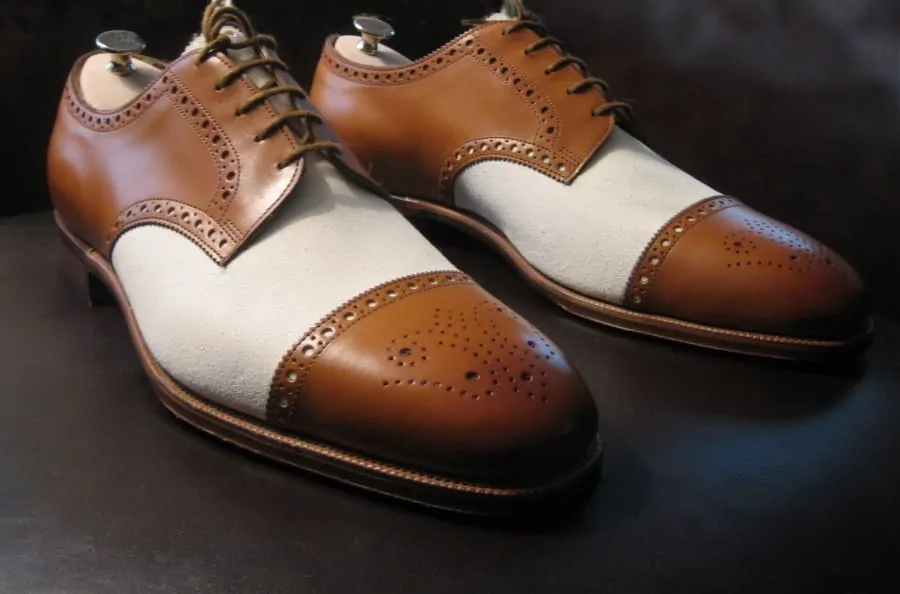
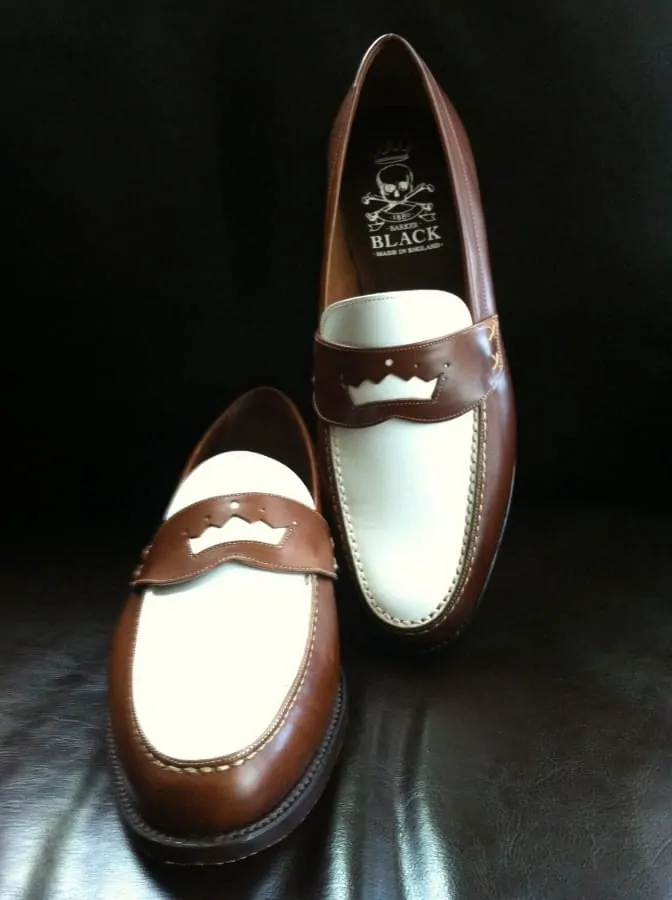
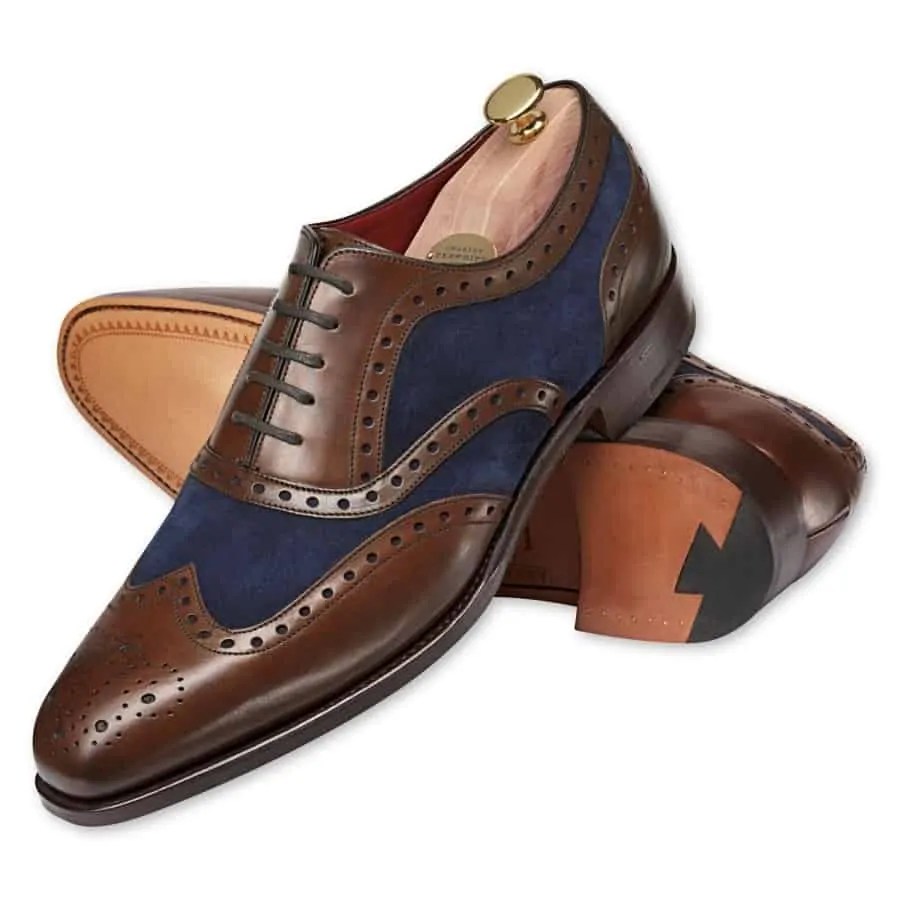
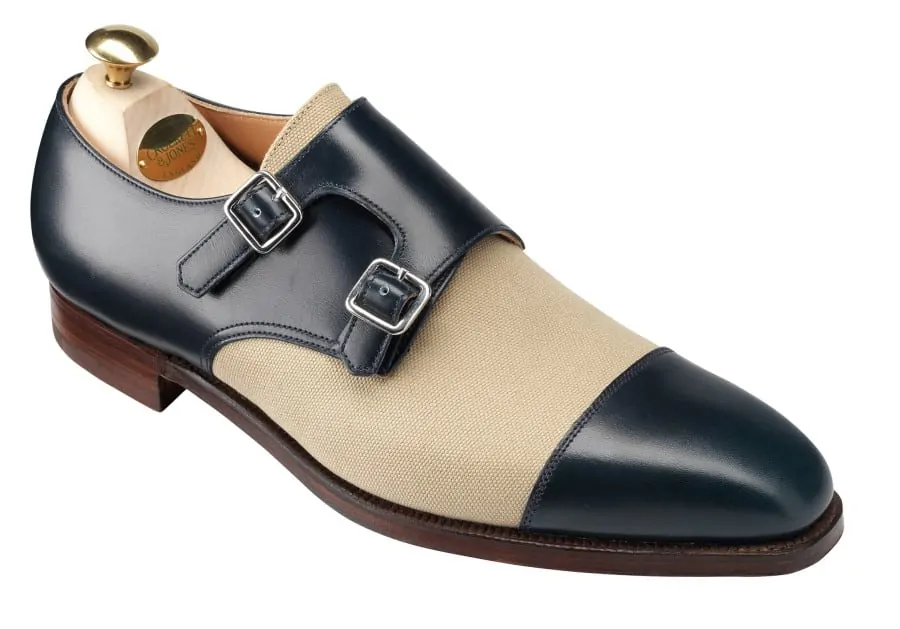
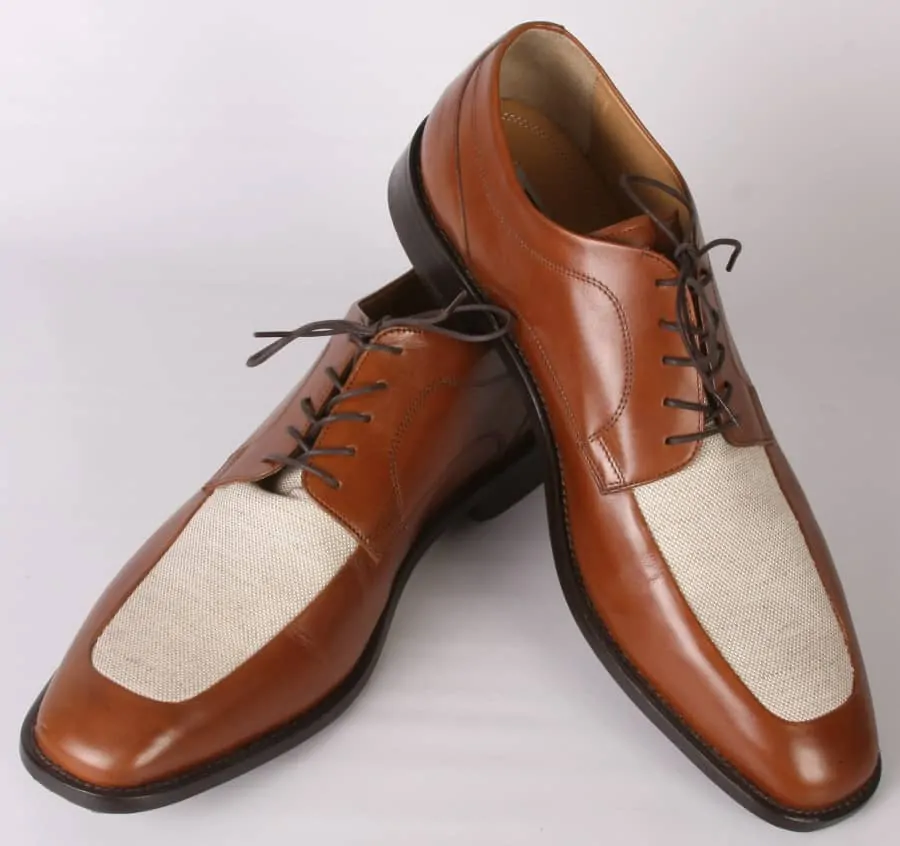
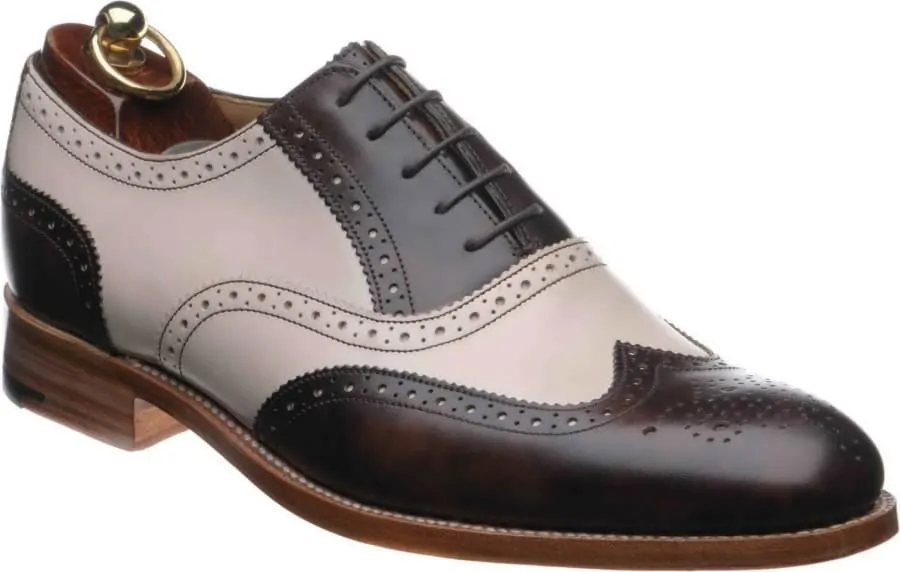
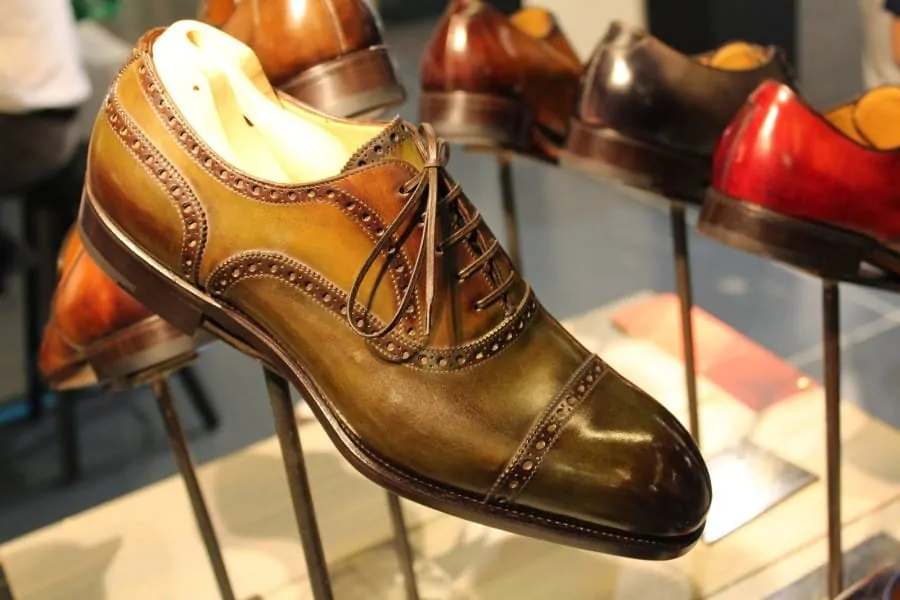
Hello Raphael and Vikram,
Nice article – but I still have got a question:
When you say that ‘The key is not wear other accent pieces’ does that mean preferably no pocket squares and no boutonnieres or how would they best be combined with spectators?
Thanks, Boris
Boris,
You can wear a pocket sqaure, but not a bright pink one, and the same is true for a boutonniere, just go with a small one in light blue or white and not a big one in red.
Does that make sense?
Dear Raphael ,
I really like this type of shoe ; the trick with the is to understate what you put them with . The other thing is don’t mess around buying some cheap candy store brand ; go for the good stuff , save your money and look well shod .
I got a pair a few years back from an Italian maker Santoni and they are real sharp , tan and white and punched caps and heels . I put them with a black Cavalry twill blazer , tan gabadine trousers and a solid white or cream shirt , barrel cuffs. The other thing is to keep them clean and treat them gentle . They make a great talking point . Make sure that ” you wear them, they don’t wear you .
Lash out lads and jump into a pair , the girls go crazy !
Mark
Good advice Mark. The one who buys cheap buys twice and ends up spending more than the one who buys good quality in the first place. This is especially true for shoes.
I had always heard that the term “co-respondent” was connected to when the days divorce in England would only be granted by the courts on the grounds of adultery. Hence, if the lady wanted to leave her marriage she and her “friend” would book a hotel in the seaside, usually Brighton, and be discovered in flagrante delictro or at least having breakfast in the booked room the next morning. When called upon to testify the gent (and I use the term very loosely) would very often appear in court wearing the shoes we love. As he was the “co-respondent” in the divorce action, they were called “co-respondent’s shoes” by some British wag.Great article.
Thanks. I left out those details since it is more hear-say than fact. In any case, the shoes are great!
In criminal court, I frequently wore specs with a pinstripe db suit, for that gangster look. Oddly enough, none of the real gangsters I represented wore spectators. Their loss. :-)
I have a pair of tan/light canvas Ralph Lauren Polo spectators that are maybe 25-30 years old. I still wear them in the summer with a tan gaberdine suit, and get many compliments. I wish RL still made this great shoe.
I think they used to be made by Crockett & Jones or Edward Green. RL never really made their own.
Interesting item, and I am concur with Mr. Henderson’s account of the “co-respondent.” That is, they refer to a the defendant in a divorce trial and are a token of what evolutionary psychologists would call “peacocking,” or when an available male is signaling his availability to females in the area. This is a decidedly British connotation, with somewhat puritanical moralizing sentiments attached to the perception of the wearer that was not the case on this side of the Atlantic.
I believe this particular issue opens the door to some noticeable lapses in your account. For instance, your claim that spectators “were favored by musicians and gangsters” and “became synonymous with the Jazz scene in the 1920s and 1930s” implies that spectators conveyed a certain proximity to the risky and even dangerous world of urban nightlife.
As a component of a highly coded ensemble that included a pin-striped, double-breasted short jacket suit with wide lapels, an incandescent necktie, a long, swinging keychain, and a broad brimmed fedora with a wide ribbon — these were all sartorial signifiers of “uptown” pushers and pimps from Prohibition days up into the early ‘50s. Spectators, often with contrasting patent leather wings, were de rigeur for this crowd.
At the same time, however, you would just as often see Bing Crosby in an open collared shirt and pork pie hat wearing a pair of Norwegian spectators puffing on his pipe. In this context, spectators were not attached to the criminal undercurrent you intimate, but rather they suggest the rakish nonchalance of a confident modern flâneur.
My own grandfather wore them throughout the forties, and he was a by-the-book protege of GM’s Alfred Sloan, the most methodical, rational, and financially successful manager that modern America had ever produced.
I think that what’s missing in your account is the fact that spectators always seemed to convey a certain sportiness, a certain sense of fun that was well within the overall context of traditional sartorial presentation. In other words, spectators emerged as a derivative of the heavily-tooled wingtip brogue that took the separation of toe-cap from vamp as an opportunity for aesthetic exploration through color contrast.
Remember that brogues came from functional shoes worn in the Scottish Highlands, shoes whose uppers had been punched in decorative patterns so that the moisture from wet bogs and marshes could drain off easily. This functionality carried with it a certain outdoorsy, folk masculinity that was easy to carry over into a more formal and highly developed iteration of the basic pattern. The military Blucher pattern follows the same kind of sporty, in this case equestrian, trajectory into the male wardrobe.
That connotation of sport was perpetuated by the enthusiastic adaptation of the spectator as a cleated golf shoe, starting in the 1920s with the professionalization of golf as a gentleman’s activity and carrying through into the 1950s and early 1960s, until modern fashion sensibility tended to favor simplicity of line and economy of manufacture.
If you look at men’s golf fashions throughout these decades, you’ll see that the sweaters, neckties, plus fours, and high hose all fall away from use, but the spectator continued to be the shoe style of choice.
Therefore, for an upper middle class male to wear a pair of spectators off the links in the United States was not an indication of his moral compass, but rather a view about his sense of an expanding self in the world at large — that he might carry a sense of fair play, of a sense of humor and a lightness of touch that might melt from the golf course into his business affairs.
I would argue that the popularity of the saddle shoe, beginning in the 1950s, was simply an extension of the values of informality and light-heartedness that the spectators initiated into the world of youth before the widespread acceptance of sneakers and tennis shoes.
In this sense, spectators carried the sense of sport and vitality into men’s wardrobes in a way that we might now associate with “casual Fridays.” I think you touch on this with the Lobb material, but it is left under-developed in what follows.
Finally, I would point your readers to the exquisite bespoke “Ohno” spectators turned out by Japanese shoemaker Tsuyoshi or TYE. (see: https://www.facebook.com/tyeshoemaker/photos/pb.247923285327139.-2207520000.1437754275./390390921080374/?type=3&theater)
Thanks for this great comment Duncan. You raise a number of valid points, especially the fun factor is true.
I look forward to more comments.
Happy to be of service!
One other citation: note these Florsheim print ads from ca. 1940. Spectacular designs and craftsmanship, and what marvelous variety of design iterations on the simple spectator theme! These look to be very similar to the pairs worn by the Kennedy men you illustrate in the article.
http://vintagehaberdashers.com/2012/06/21/florsheim-spectator-shoes-1939-1940/
Thanks for this about the two-toned shoes. I have long been a fan of this type of footwear and plucked up the courage a couple of months ago to purchase a pair – not to badly priced by a company named Loake in their ‘life-style’ range. I thought they might attract the wrong type of criticism but so far all has been very positive. I hope they don’t become too popular as I like to feel a bit our of the ordinary when dressing up. I took your advice on bow ties which have again attracted the right level of comment.
Thanks for the Gazette best regards RDH.
Excellent RDH, glad we could help. Please share GG with others that might find it interesting.
I have a pair of Allen Edmonds’ Broadstreet: A very smart summer spectator. They are awesome! Does it take confidents to wear them? With the right outfit and your head held high your confidents will grow as the function you are attending goes on!
Very true and a good point.
I have a pair of Cole Haan LunarGrand Wingtips in black & white that are very comfortable and get pleasantly noticed. I’ll wear them with a dark (black, navy or grey) suit or slacks. Just bought a pair of ShoePassion No. 381 brown & white perforated-upper Derbys to wear with my brown, tan or linen suits or slacks in the summer.
I am so very pleased to find such gentleman of taste & style as modern society seems to grow more shabby all around us.
Thank you and good day, sir!
You are welcome Duncan!
Thanks for sharing your comments. I am interested to hear how the No 381 works out for you.
I’ve worn spectators starting in the early ’80’s consisting of many makers. Loafers by Bennis/Edwards, 1 pair black/white and 1 pair brown/white were stunning. Currently have pair made by Brangano, brown leather/tan canvas that are cap toe, they look great. I prefer cap toe vs wingtip, also brown vs black, and minus the brogueing.
To my eye, spectators are stunning summer wear, Not only that, you will stand out as how many men will you encounter wearing them not to mention women who take note of those wearing specs! You don’t need a pick up line.
They look great with white/off white flannel or gaberdine trousers and blue blazer, grey or blue trousers and a sport coat. The combos are endless.
Hi
Great article. Do you know the make of the cool looking red/black boot you have illustrated ?
Cheers
Aubercy.
I have worn them for years. I have three pairs, two Oxford’s,and a pair of loafers. The oxfords are black/white, brown/white, and the loafers are brown/white. I wear them only in the summer. I wear the brown/white Oxford’s for golf,with off white linen slacks. I wear the black/white Oxford’s with a navy linen Blazer, and off white linen slacks, and also with a seersucker suit. The brown/white loafers are worn with various casual outfit’s.
Dear Raphael,
A very interesting article with some pretty nice photographies of different spectator shoes!
Since a long time I like spectator shoes and I recently received my new ones from England, wing-tips in tan/white. Besides the outfits you did describe to combine with spectator shoes, I like to combine them with very conspicuous items. My favorite look is my boater hat, a navy-green striped boating blazer, white trousers and at the bottom the spectators. A white shirt is as background let shine the colors of the blazer even more. Perfectly completed is this dress with a white boutonniere, a white pocket square and a blue bow-tie. You can see this particular dress at my post http://adandyslife.com/a-dandys-concours-delegance/
Love those two tone especially the wingtip brogues , but I’m more concerned with looking after them and cleaning them as I have both brown black and dark brown shoes , might need to buy a new set of brushes . I see Loake shoemakers do fine two tone wingtip brogue called the sloane in both brown and black , and Barkers do two tone as well .
I’m digging this site, and this is a great post. I found your site through The Modest Man. I am very pleased with the way the site looks and the content. I’ma huge fan of wing tips, and I can hang with a gentleman who isn’t scared of the two tone wing tips! I wouldn’t mind having the wing tips from dancing in the rain. Gene Kelly knew how to rock the wing tips!
Here in the rather conservative Netherlands Spectator´s shoes will be frowned upon as stuff for Maffiosi of Pimms. I´m afraid.
So what advice or techniques have you for polishing Spectators especially where one colour is dark and the other is very light ?
Excellent article and photos. i discovered a theatrical and ballet shoes cobbler in San Jose, Costa Rica named Giovanni. He makes leather spectator shoes to fit your foot outline. One chooses the colrs and style ( regular or tassled loafer) . Five days. I have sent them to family and friends as gifts. My son wore a pair at his wedding.
The co-respondent’s shoes were left outside the hotel room to be observed as evidence of marital wrongdoing, made more reliable by their distinctive appearance.